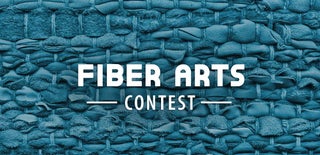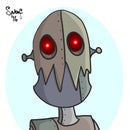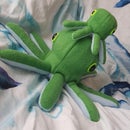Introduction: Small Soft Toys From Printable Pattern
Everyone loves soft toys, right? Right? ...Guys?
I do, at any rate, and I like making them, too. I make these from fleece, which doesn't fray, so if you're using a woven material that does, you'll have to add a seam allowance - that is to say, you'll have to leave a bit of extra room when you cut your pattern pieces, because you won't be able to sew as close to the edge as you can with fleece.
I lasercut my pattern pieces from the fleece, using high-speed, low-power settings. If you want to do that, download the svg files named by animal - I've named the files for the colours I used in the examples, so obviously you may want to rename these if you're using different colours, or just keep an eye on it. If you haven't used your lasercutter for fabric before, definitely use a scrap to test the settings and get them just right.
If you're using fleece, be aware that it's plastic and will melt a bit under the laser. Keep the fluffy side, that you'll want on the outside of your soft toy, facing up when cutting - any melty bits will pool at the bottom and not interfere with the snuggliness of your final product. Again, testing is essential so you can minimise any melting in the first place.
I'm going to write this Instructable as if you're cutting with the printed PDF pattern - if you're cutting it by laser, skip all those bits and move onto step 2.
Please note that it is your make, and it is always up to you to adjust or adapt as you see fit! You don't have to use my stitches or my techniques at all - do what you feel works best for you, or what you want to try.
Supplies
Ingredients:
- Scissors,
- The fabric you intend to use,
- Your printable pattern,
- Fabric scissors,
- Thread (if you read the summary of the stitches we'll use, you'll get a clearer idea of the colours you'll need),
- Needles,
- Pins or clips,
- Soft toy stuffing,
- Pencil or other thin, hard object to help with turning the finished piece inside out,
- Tailor's chalk or fabric pen (optional).
Step 1: Cut Your Pattern Pieces.
This step is only for those who have decided not to lasercut their pattern pieces. If you have lasercut them, skip to the next step.
To cut your pattern pieces by hand, print the pdf pattern onto an A4 piece of paper. You can pin the paper pieces to the fabric and cut around them (don't forget to leave a seam allowance if you're using a fabric that will fray, I recommend cutting 5mm outside the pattern pieces to allow for some fraying, and using pinking shears if you can), or you can use tailor's chalk or a fabric marker that will wash out or fade with time, to draw around them.
The pdf contains instructions for how many you will need of each piece, and has guidelines as to which pieces are for which animal.
Attachments
Step 2: Overcast Stitch.
I use this overcast stitch to sort of draw on fabric with more fabric. For example, to sew the pink bits onto the front of the bunny ears, the stripes onto the raccoon's tail, or the face onto any of these.
In the diagram, I have made the fabric look bumpy on top and flat on the bottom - this indicates which side of the fleece is the fluffy side. As fleece has two sides, it's worth paying attention and making sure you have the fluffy side on the outside (or the non-fluffy side, if you prefer that) because it'll feel cuddlier to the touch. If you're using cotton or another woven fabric, that side will be the one on which the colour is brightest. We call this the right side, and the other side the wrong side. If you are using wovens, give these pieces a bit of extra space when cutting, and tuck the edge under when you sew to prevent fraying.
To make the overcast stitch work, we put the wrong side of, for example, an eye, against the right side of the face. When we look at the face now, we see both right sides at the same time. Pin into place, or clip if you have clips. Another technique is to tack them on by putting a single stitch in a few places to ensure the eye (for example) stays in the right place while you sew.
Insert your needle into both pieces of fabric from the wrong side, just a millimetre or two from the edge of the eye. Your needle should be coming out on the right side, so pull all the thread through. The knot you tied at the end of it will come to rest on the wrong side.
Now reinsert the needle into the bottom fabric only, just over the edge of the top fabric. In our example, we've pulled the needle through the face and the eye, just a millimetre or two from the edge of the eye. Now we're reinserting it just over the edge of the eye, so it only goes into the face. Carry on around the entire piece, in small even stitches. It's your choice whether you pick a thread matching the eye colour, which will mean the stitching disappears into the fluff of the fleece, or a contrasting colour to emphasise the fact it's a hand-stitched soft toy.
All of the pieces which need to be sewn on with an overcast stitch are indicated in the pdf pattern with a red dotted line along the edge.
I leave a tail hanging beyond the knot in my thread, and when I come full circle I tie what remains of the thread to that tail to anchor it. I like to sew all the overcast stitching before I move on to the running stitch.
Step 3: Running Stitch.
A running stitch is probably the most well-known hand-sewing stitch. One of the kids at the tech club where I volunteer calls it "the up and down," and that's just what it is. Place the two pieces of fabric you want to join, right sides together, and insert your needle where you want the seam to be. For fraying fabrics, that'll be on the line where the paper pattern piece would have been. For fleece it can be a couple of millimetres from the edge.
Now simply insert your needle, moving up and down, pulling all the thread through at least every other stitch, until you've sewn the entire seam.
This stitch is used in these patterns to make 3D pieces - for example, sewing two halves of the cat tail together, right sides facing each other. Then we turn them inside out and the stitches are hidden, while the right side of the fabric is on the outside where it can be seen and touched.
I like to sew the ears and tail, and then begin assembling the lot. To assemble the rabbit's tail, I sew all the little triangle cutouts together, then turn it inside out.
Next, I attach the tail to the body piece that has a tail hole. I clip or pin the tail into place, and sew around the tail hole, making sure to catch both the tail fabric and the body fabric with every stitch.
Next, I clip or pin the neck to the neck hole. This is the round cutout at the bottom of the face piece. The round cutout is sized to fit the straight neck precisely, so just let it curve around. It's well worth spending a little bit of extra time on pinning/clipping to ensure it takes a nice shape when finished. Make sure the right sides are facing each other.
Once both head pieces are connected to both body pieces, we're ready for the final assembly.
Step 4: Final Assembly.
Now that all the pieces are together, it's time to assemble. Lay the front side flat, right side up, on a surface. Place the ears where you'd like them, flat onto the face - don't position them the way they will be when the piece is finished, but place the front of the ear flat onto the face and match up the bottom seam with the outer seam of the face. Now put the back piece, right side down, on top and manipulate the ears so they're where you want them to be.
Start pinning by pinning the seams where the head meets the body, as you really want those to match up. It's worth putting some extra pins where you intend your sewing to stop. You need to leave a gap to turn the lot inside out and then stuff the toy. You'll be closing this up with a ladder stitch at the end of the project. To keep a long tail out of the way, tuck the end in between the face pieces so the tail sits comfortably between the two side seams. Take care not to catch it when you sew past it.
Start sewing at one armpit, heading around the arm and up around the head. When you come to the end of the second leg, leaving only a gap between the start and the end, finish your stitching. Because the beginning and end stitches will be taking a fair bit of stress during turning, it's worth repeating the first and last stitches 2 or 3 times.
Step 5: Turning.
To turn your toy right side out, grab a pencil or another thin, hard piece of equipment and use it to gently poke the arms and legs out. You can use the tail and the ears to help you pull a little bit, but remember that going slowly and gently is a good idea - you don't want to yank on the fabric and warp it.
Use the pencil to tease the head and body into the right shape.
I'm terribly sorry, I didn't have any of these pieces to hand as I wrote the Instructable well after finishing them - the example images are from a different project but illustrate the principle just as well.
Step 6: Stuffing.
Stuffing works best if you do it in small bits. Large chunks of stuffing tend to hold their shape as a chunk, rather than adjusting to the shape of the toy, so tearing off small bits and stuffing them in, even to fill a larger space like the head, tends to render better results.
Stuff the tail, as well, since there is an opening. You may want to experiment with levels of stuffing - some people like quite a firm stuff, others like it a bit looser.
I'm terribly sorry, I didn't have any of these pieces to hand as I wrote the Instructable well after finishing them - the example images are from a different project but illustrate the principle just as well.
Step 7: Finishing Touch!
Now that your soft toy has been sewn and stuffed, you can close it up using a ladder stitch, and your soft toy will be finished!
Start by inserting your needle into the seam of your turning/stuffing gap. To do so, put it inside the toy, and sew as you would if it were still the wrong way out. Now follow the line your seam would have taken had you closed up the entire toy, and sew small stitches on one side, then the other, allowing you to pull the entire thing together at the end.
Tie off carefully, and try to tuck the knot into the seam at the end to make it invisible.
Your soft toy is finished! Congratulations! Please show me the finished result, and let me know especially if you adapt the pattern!

Runner Up in the
Fiber Arts Contest













